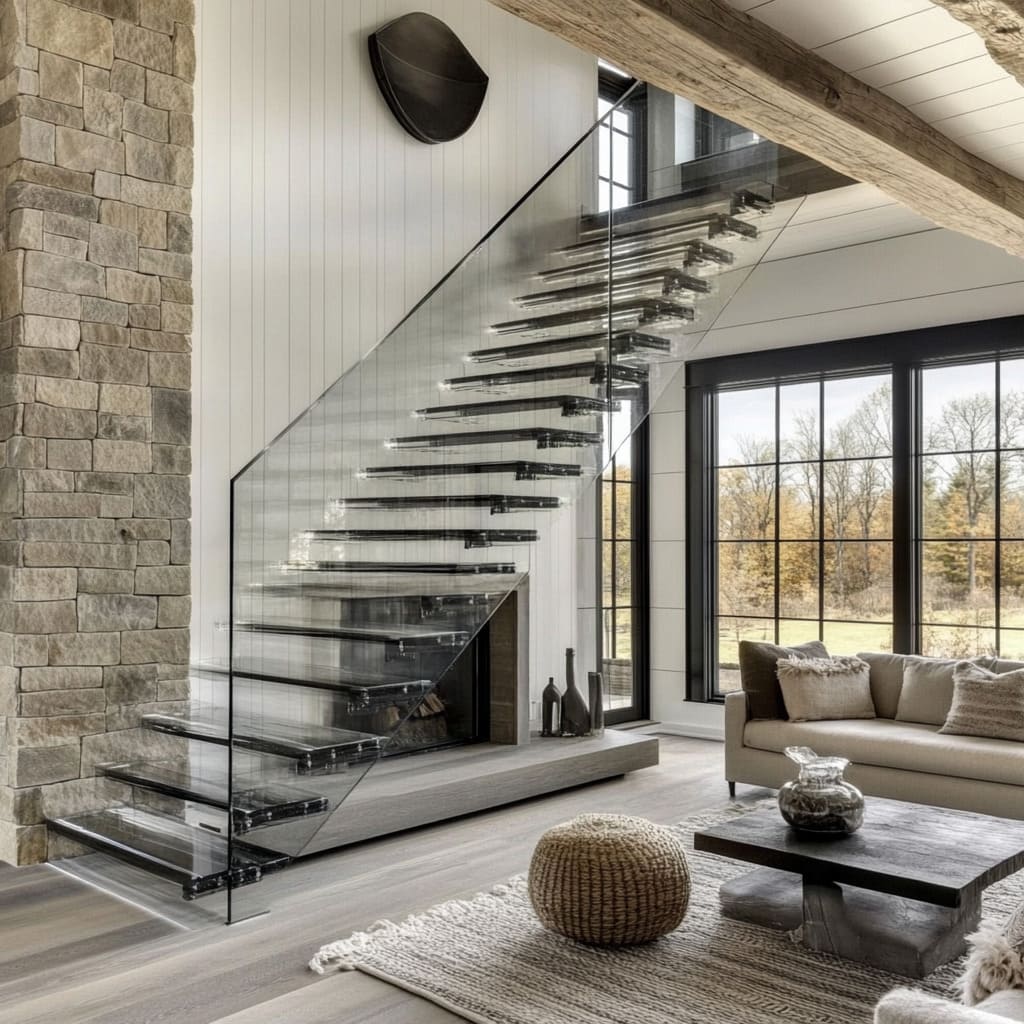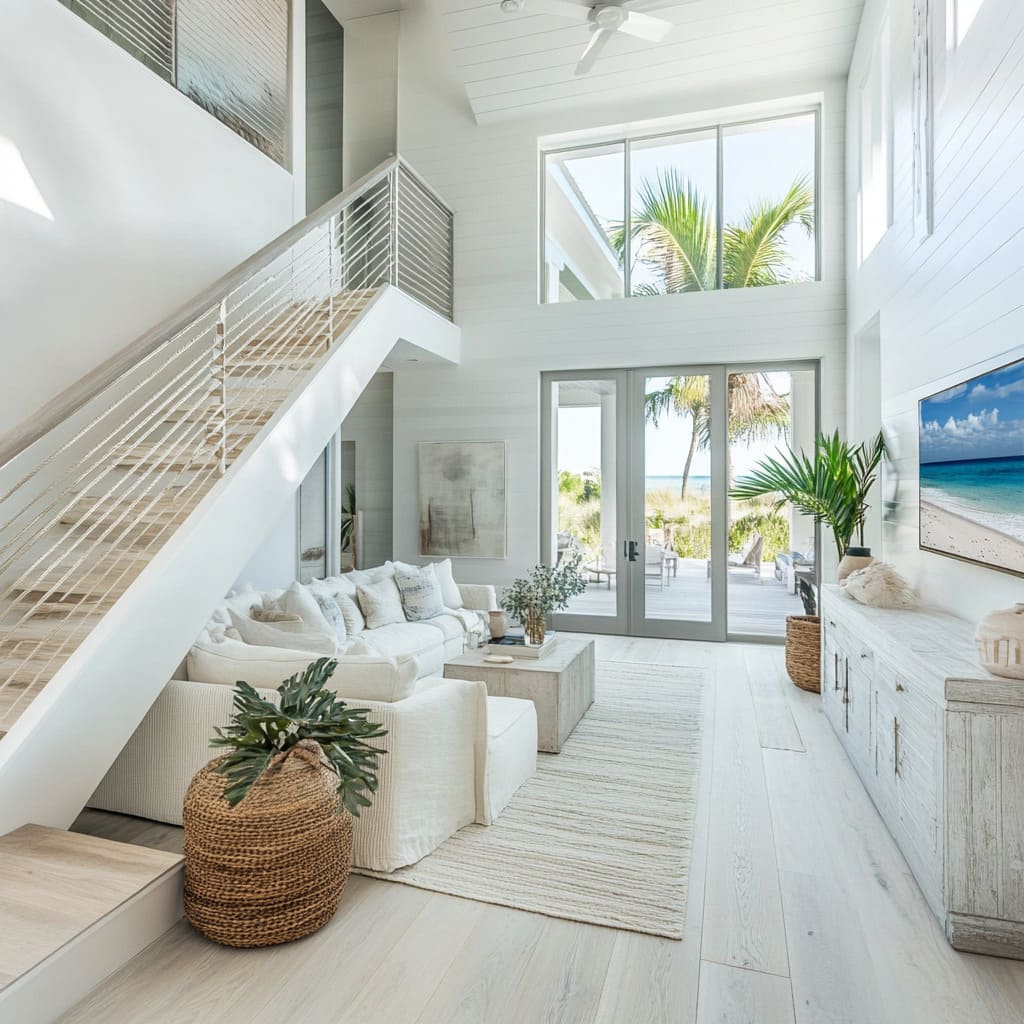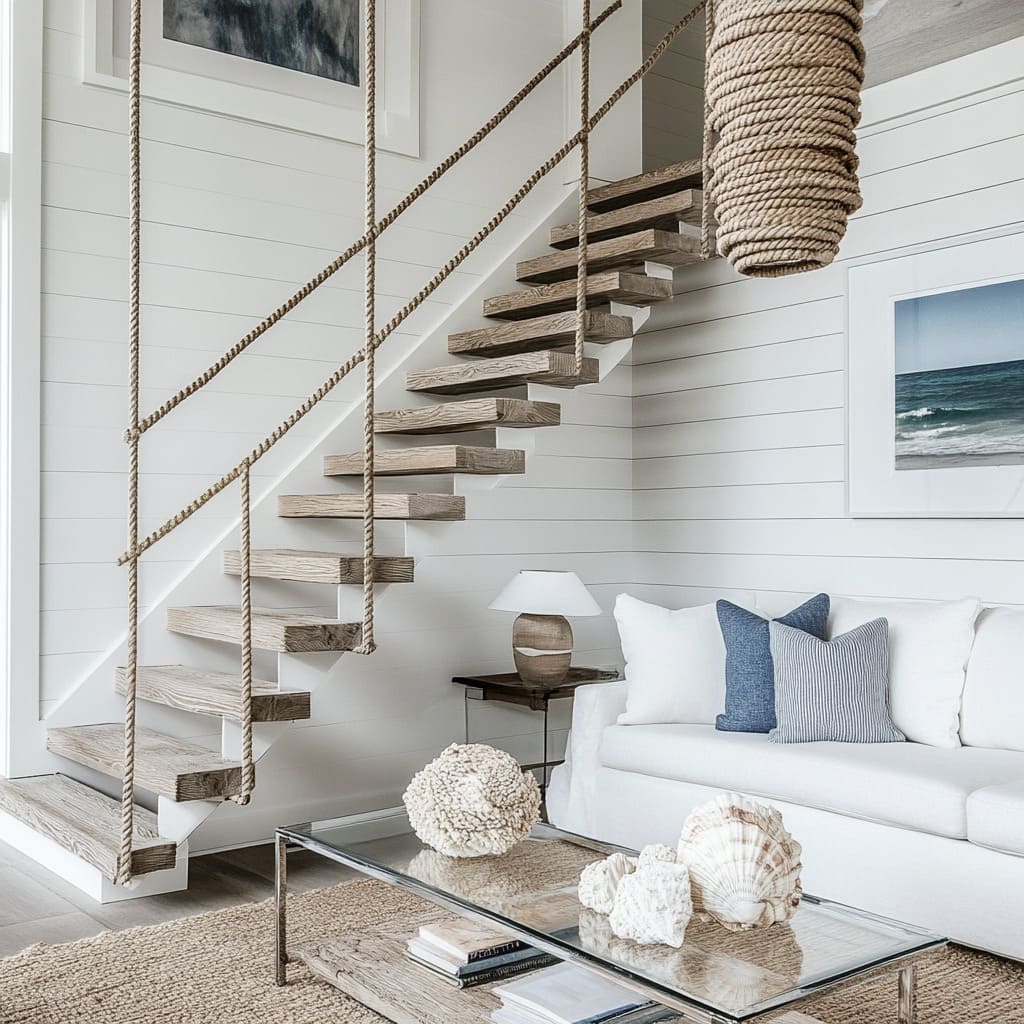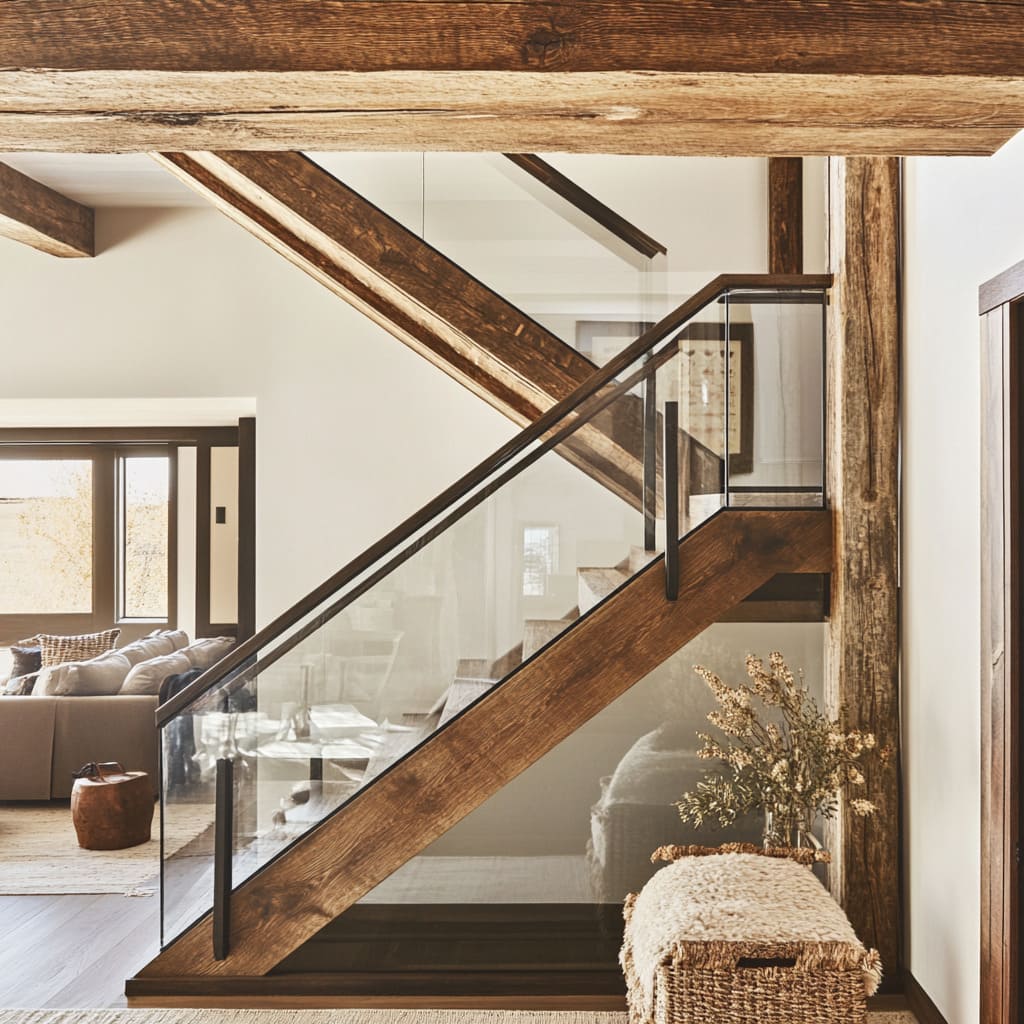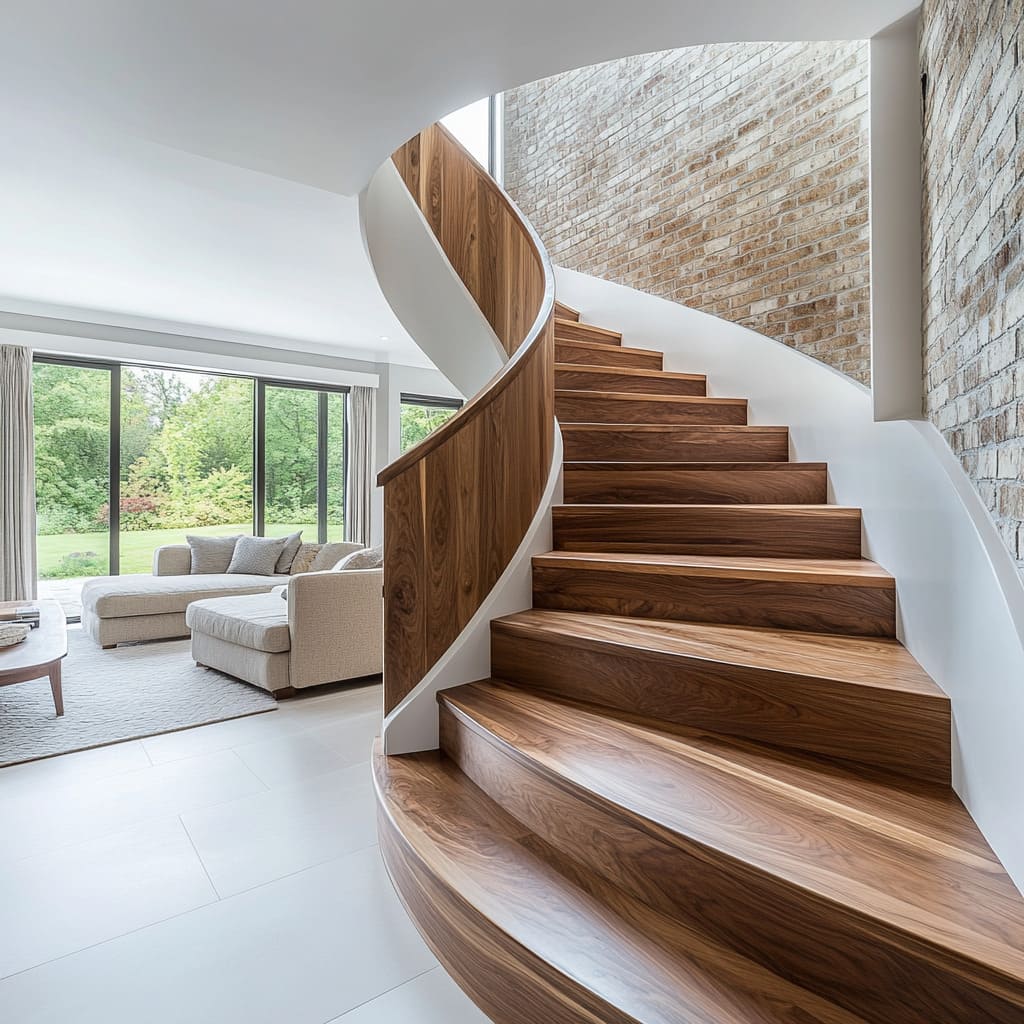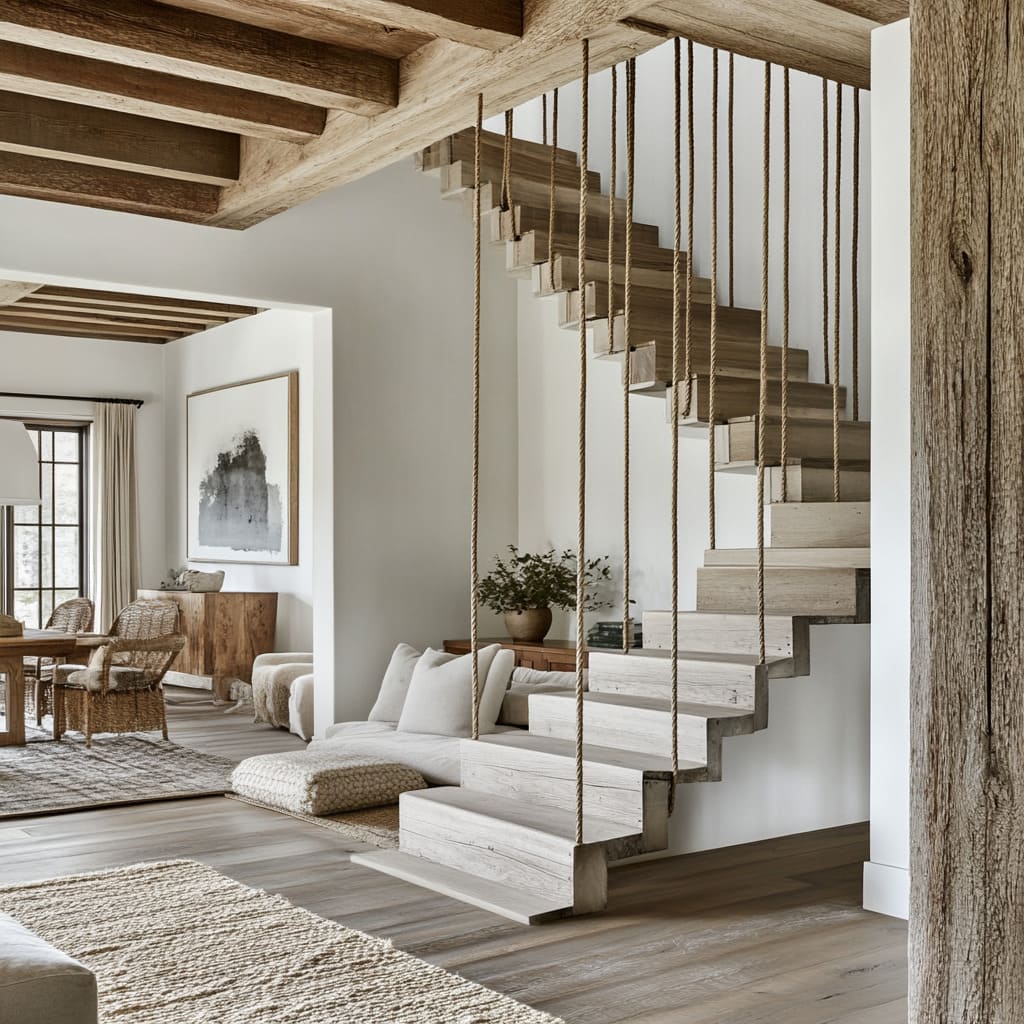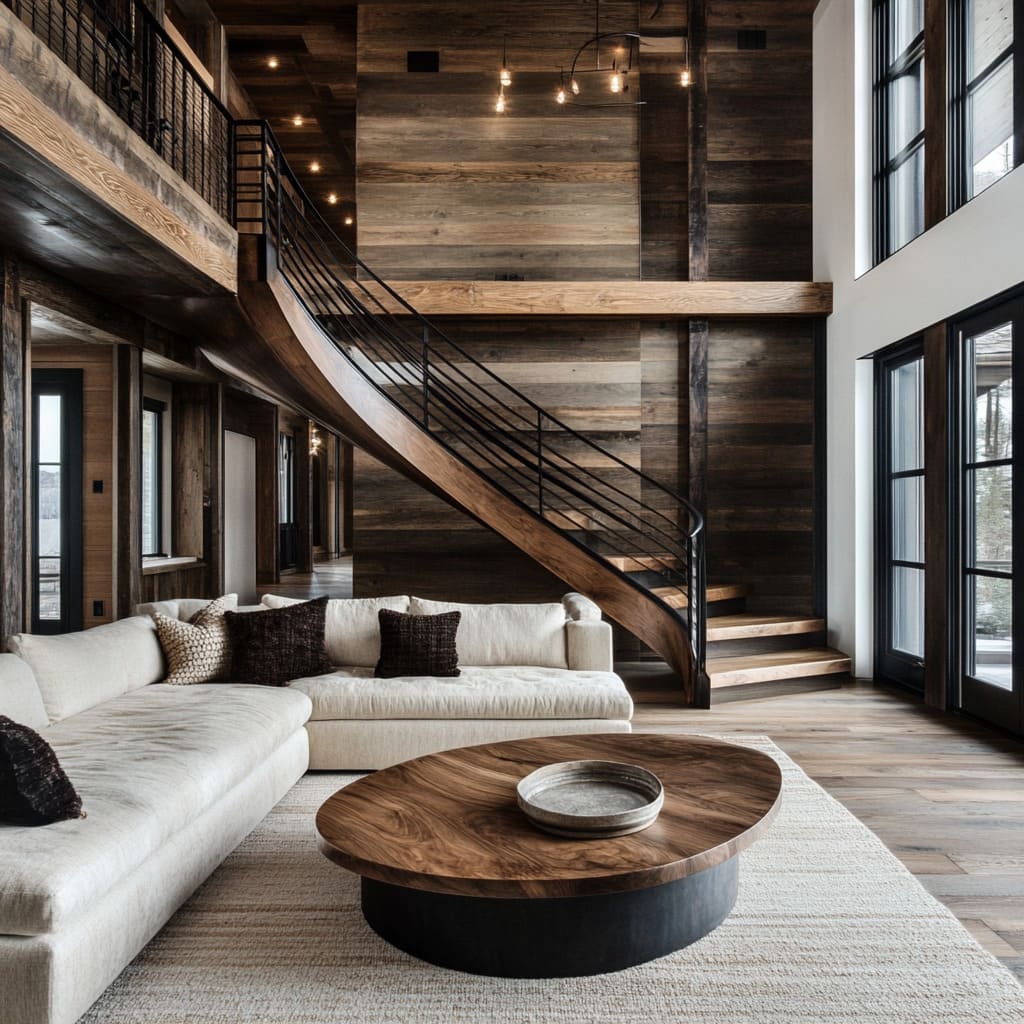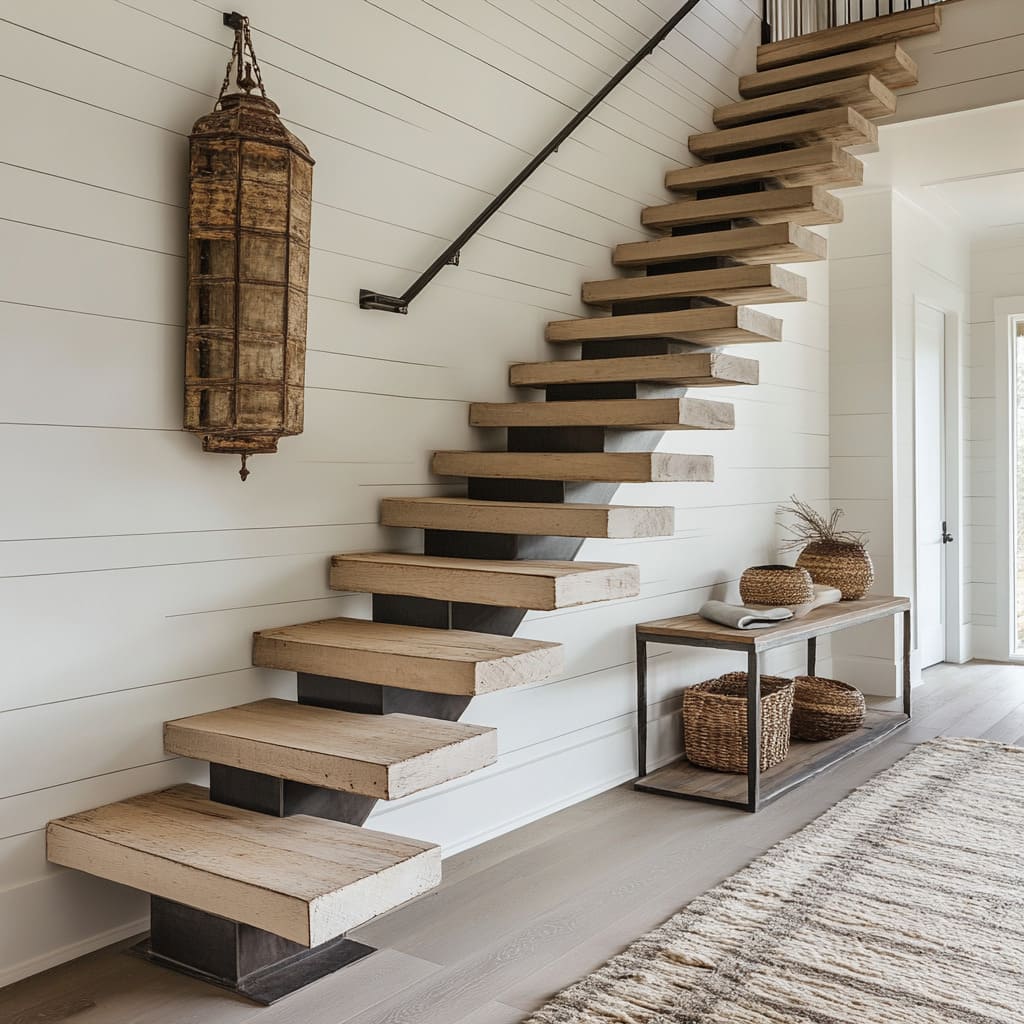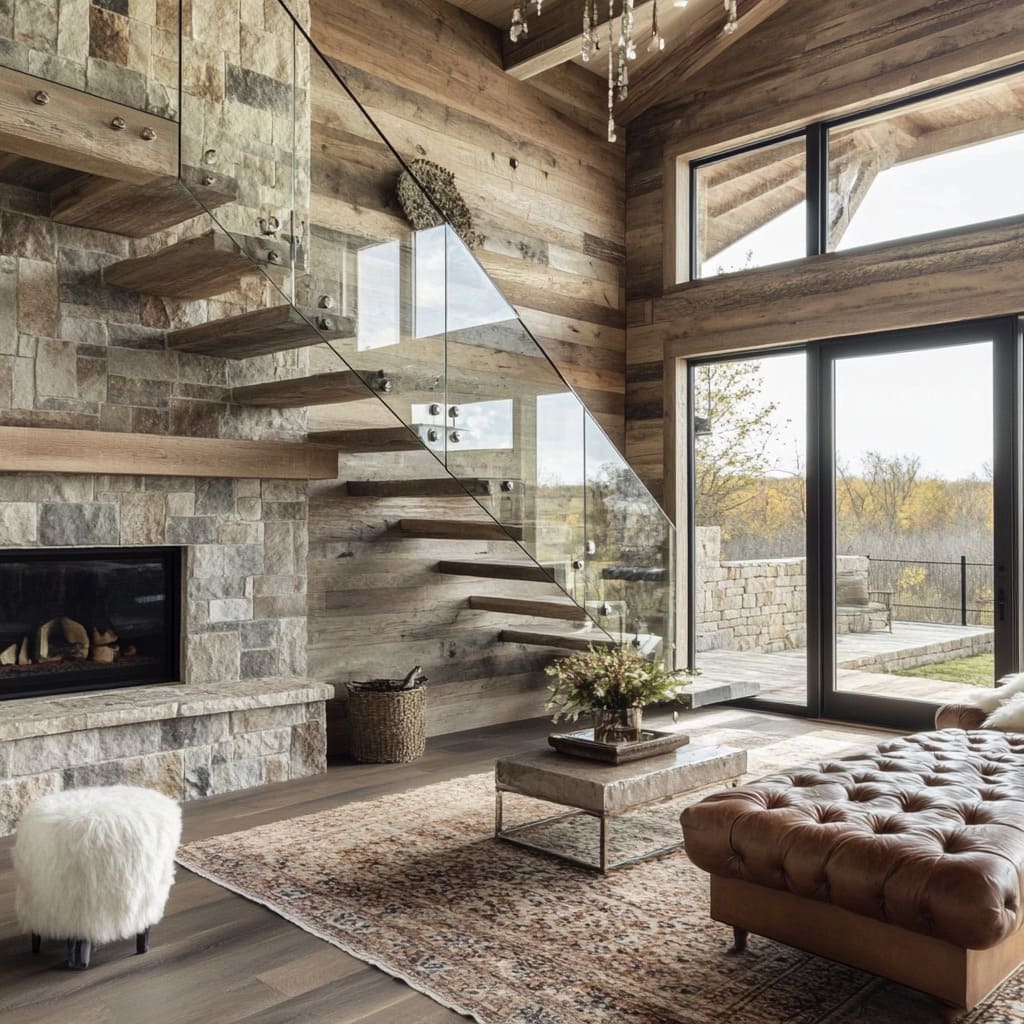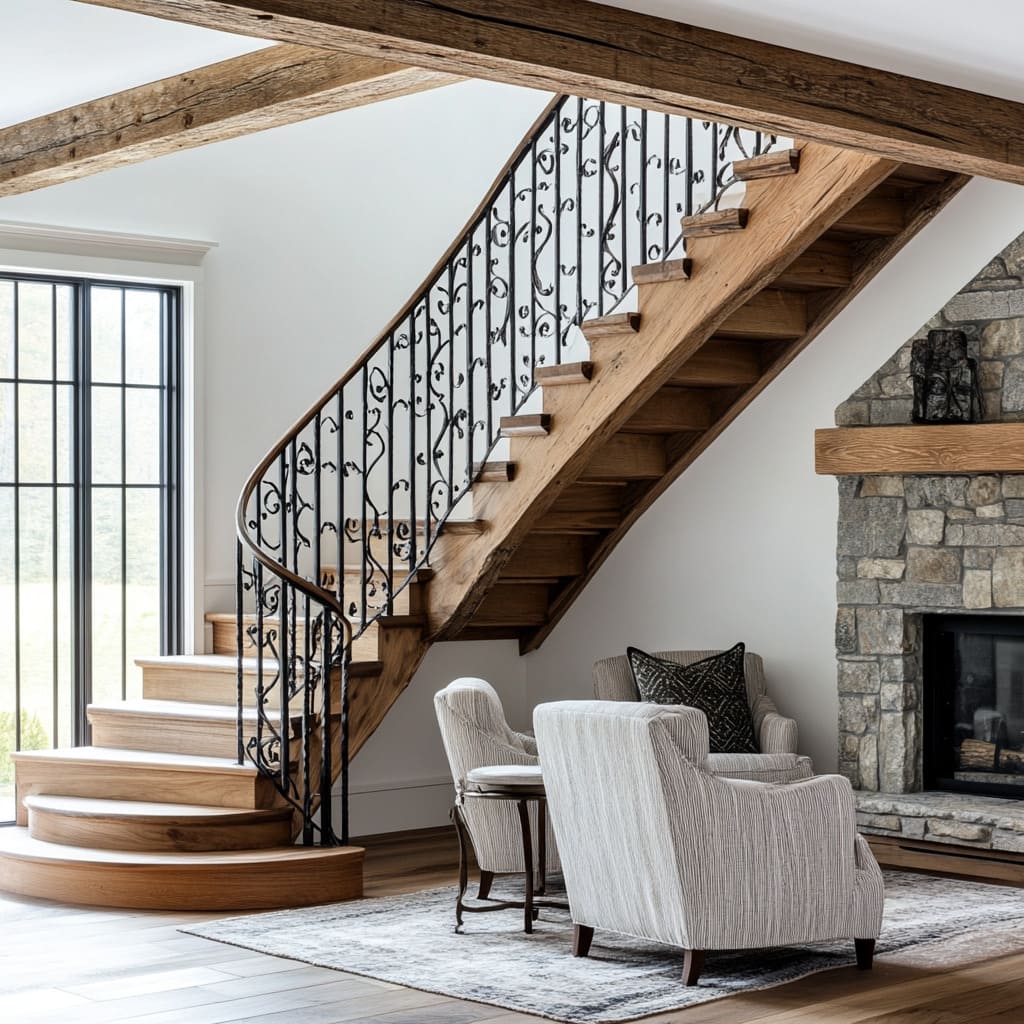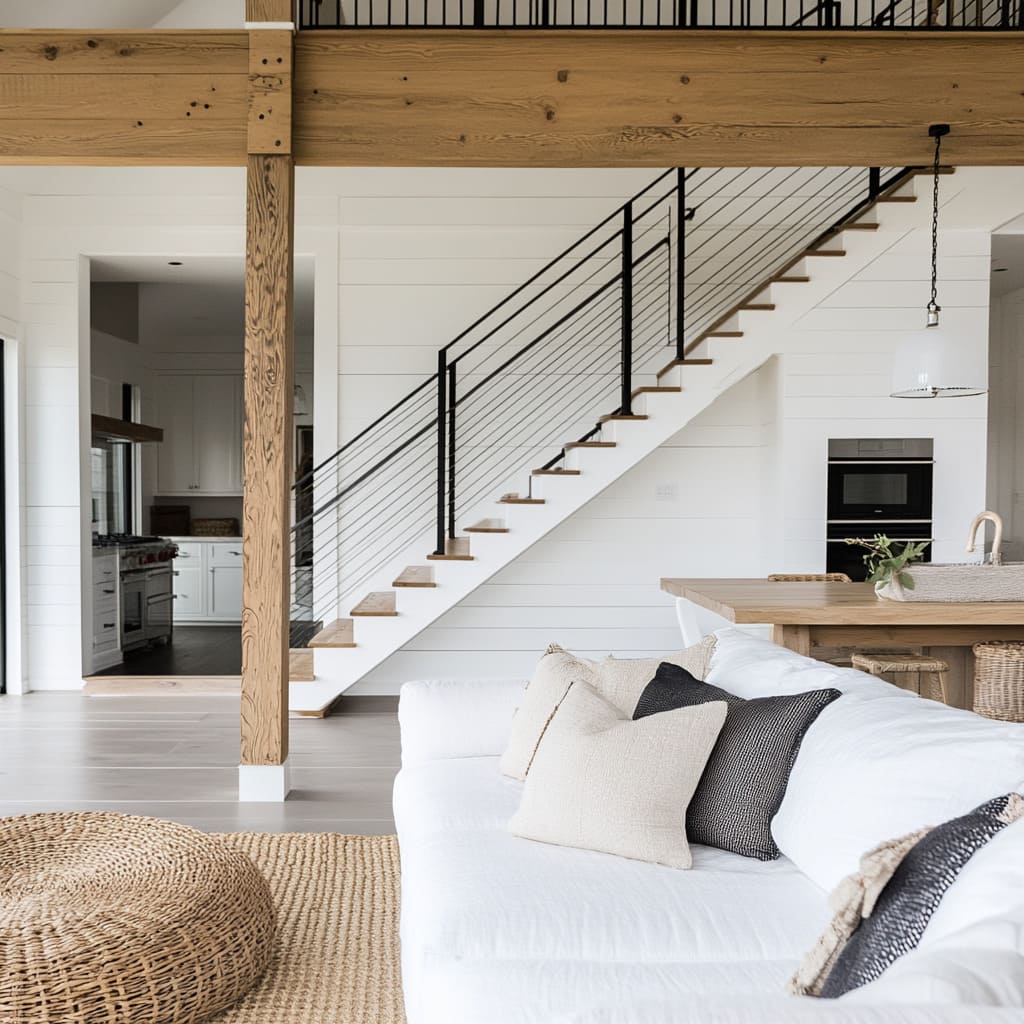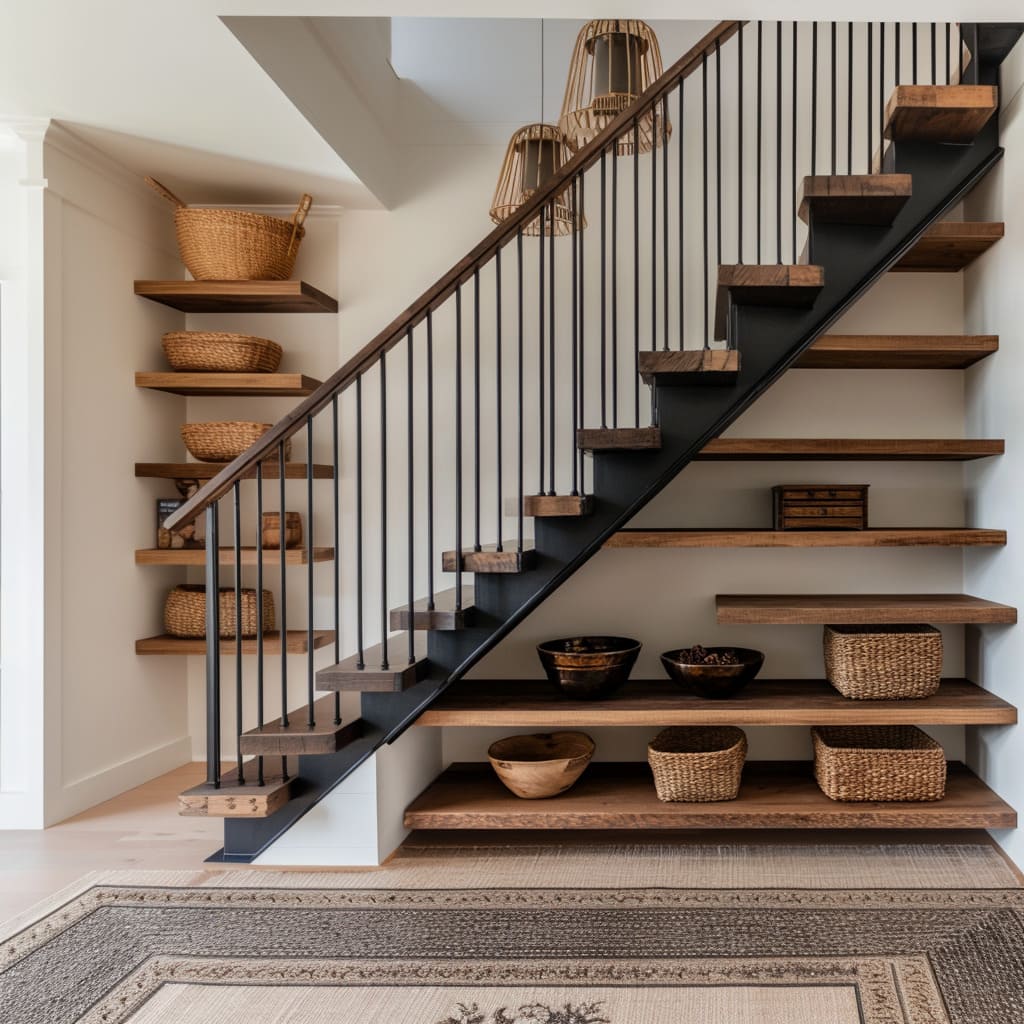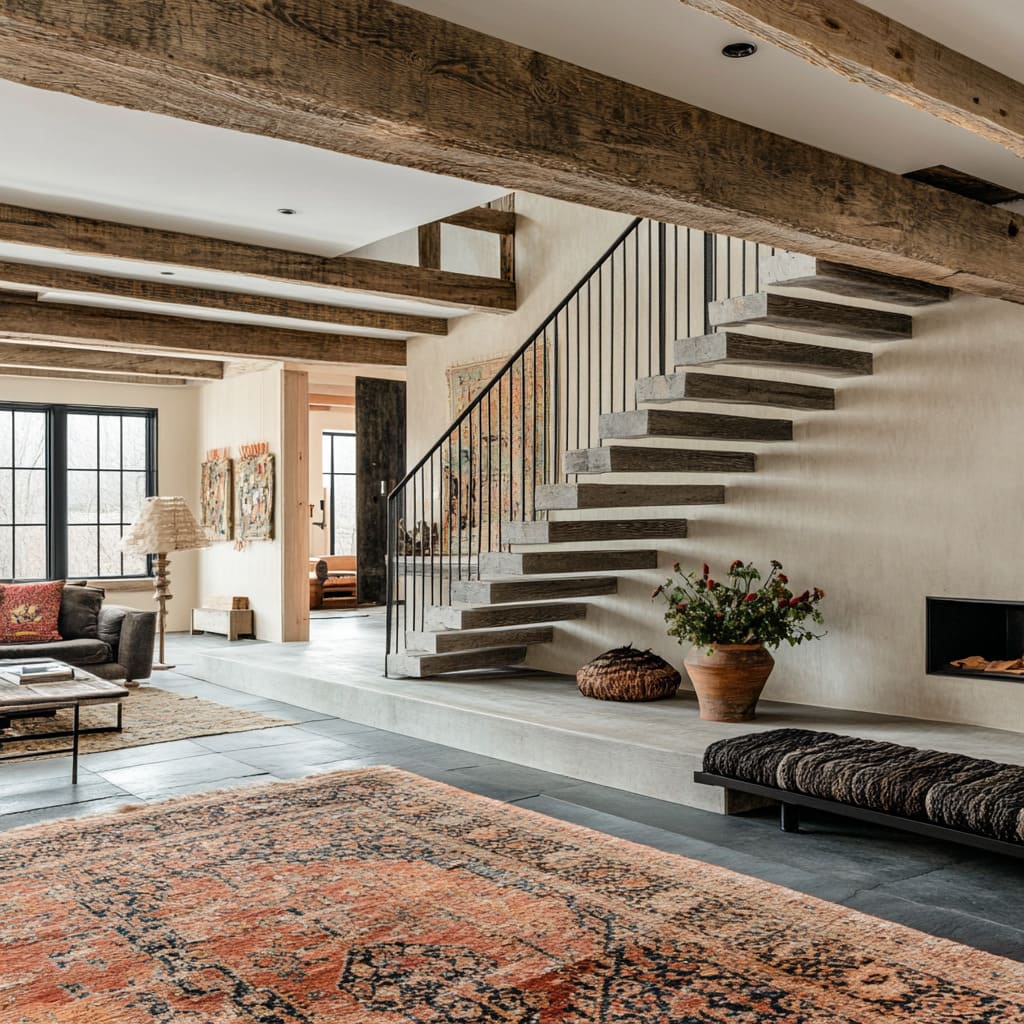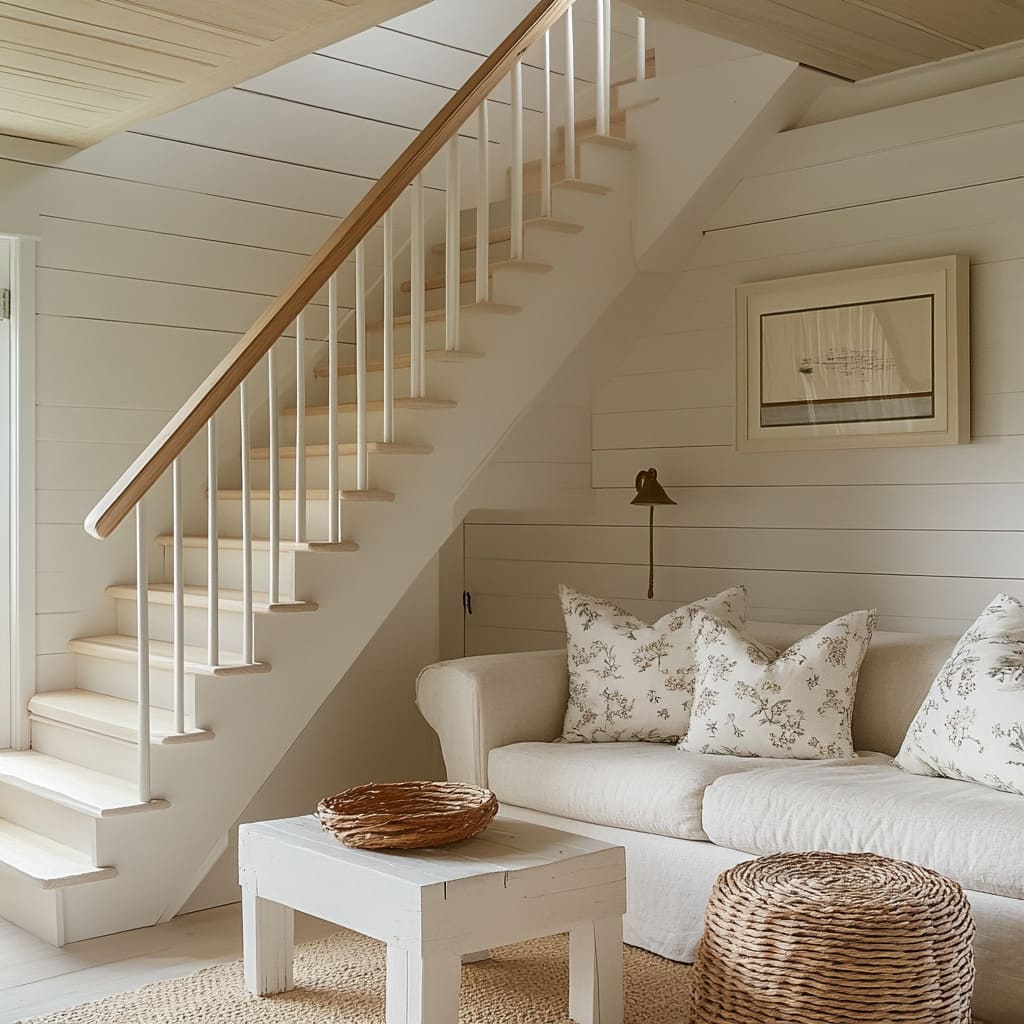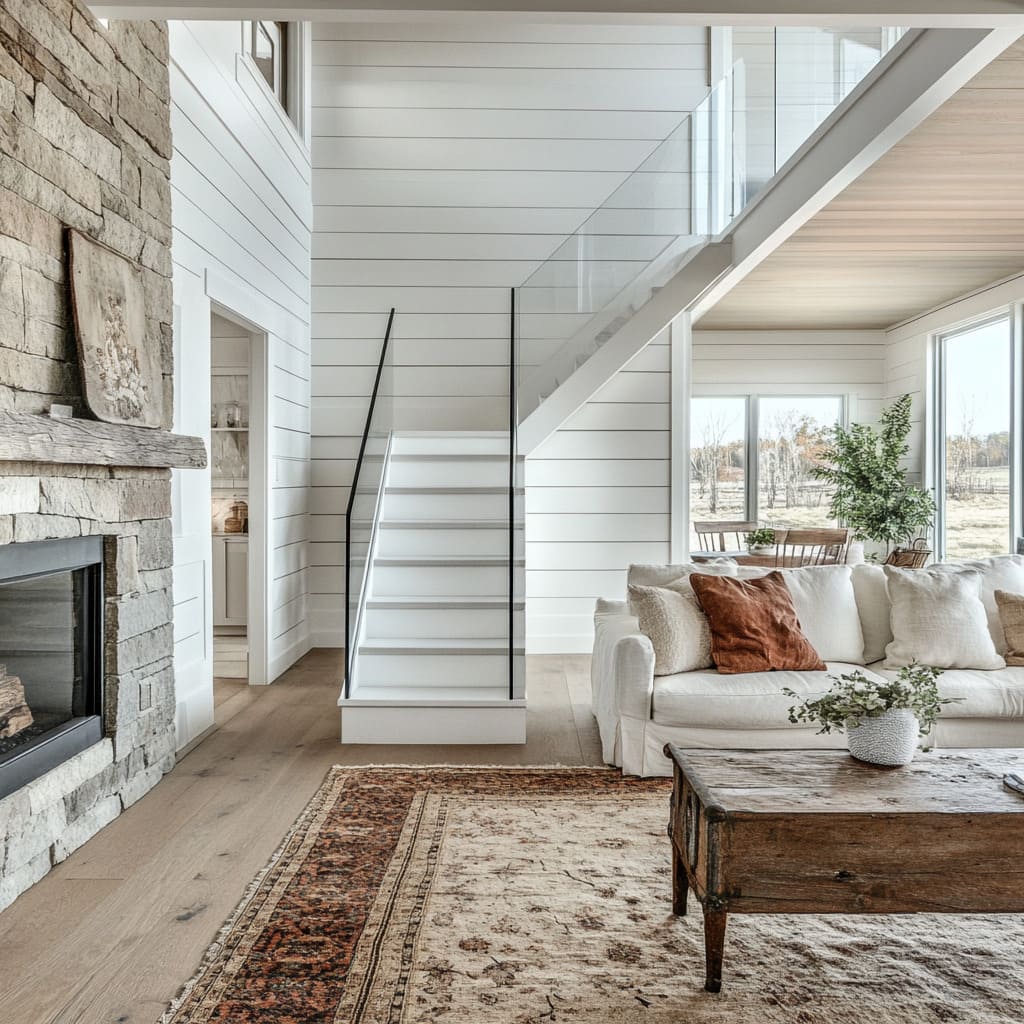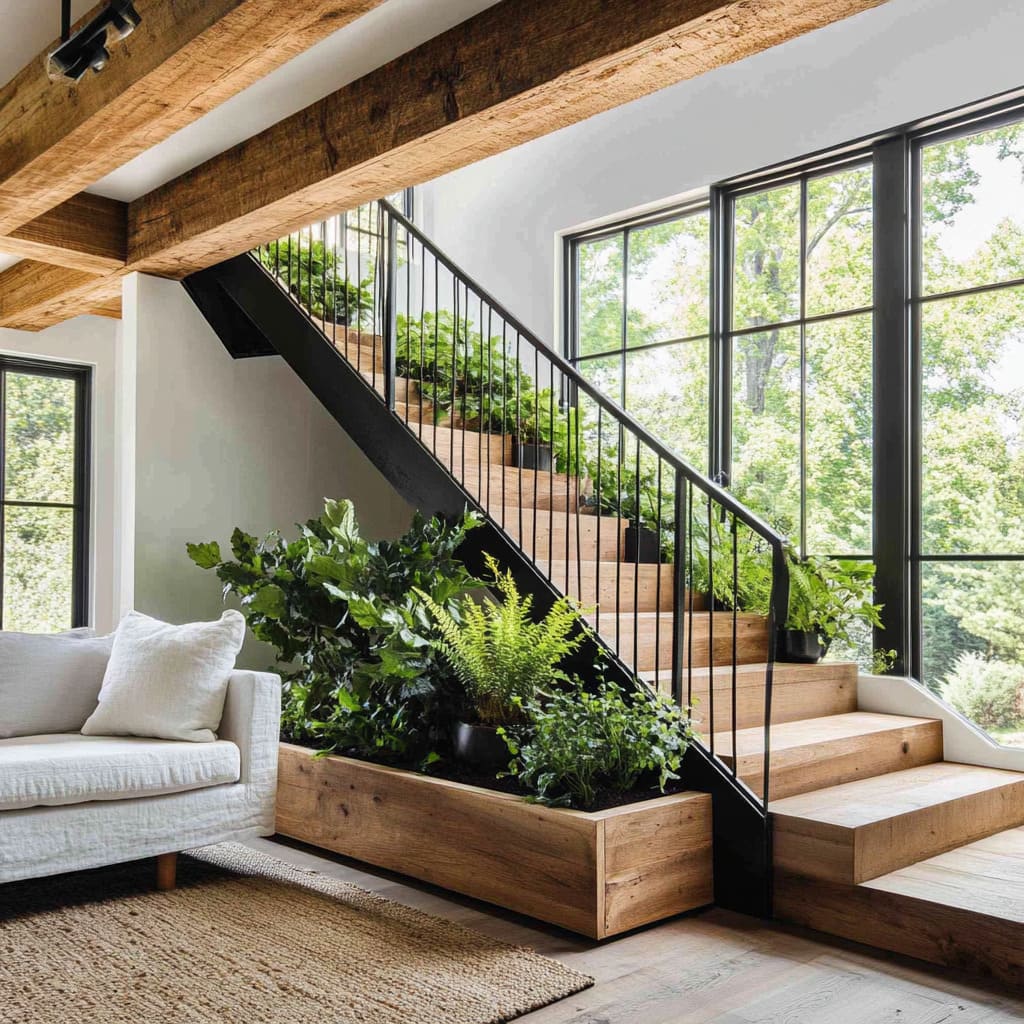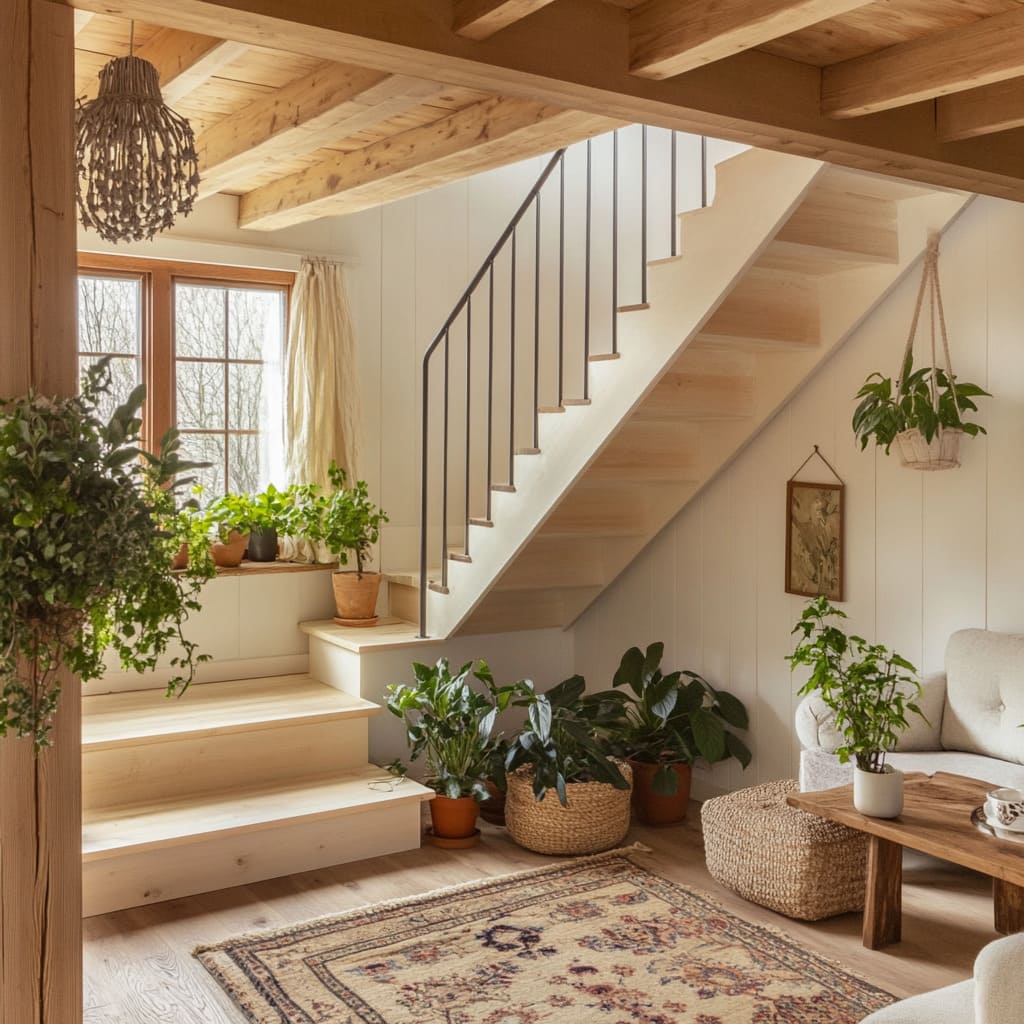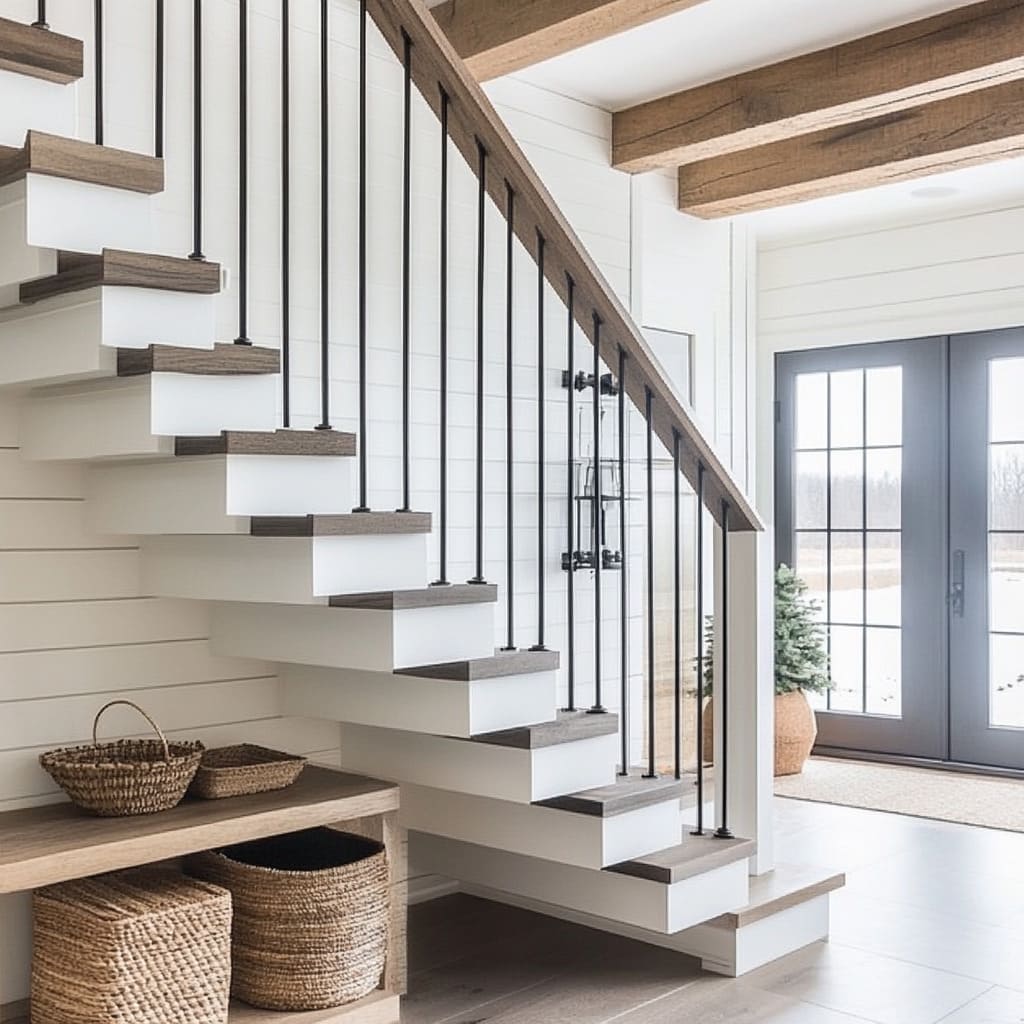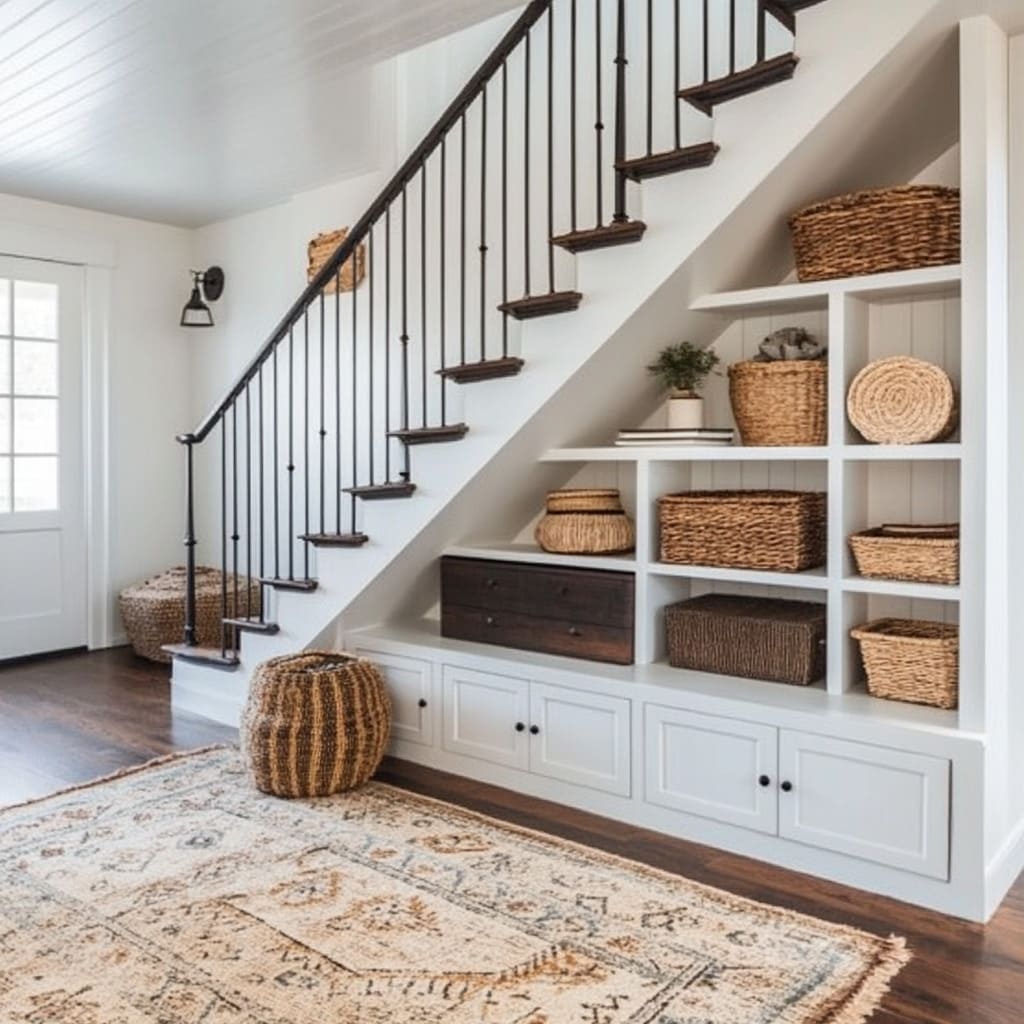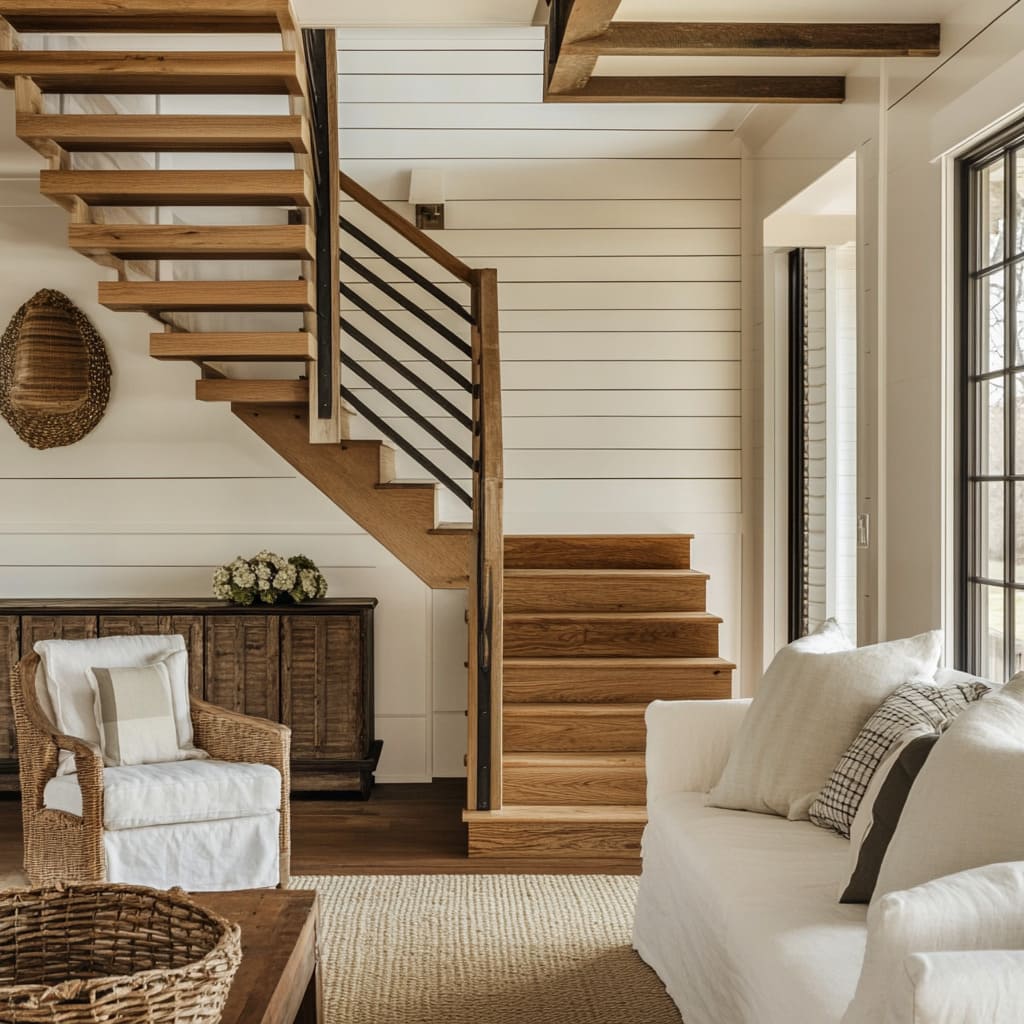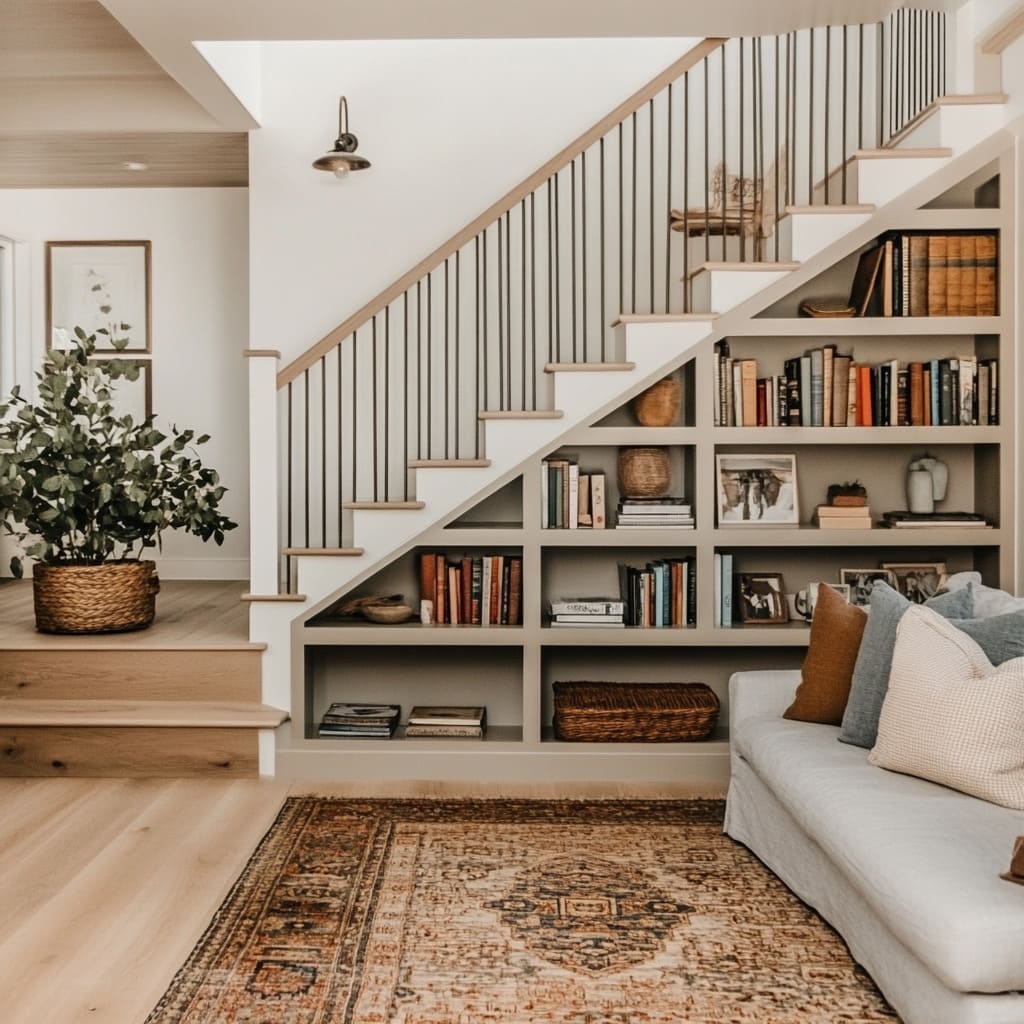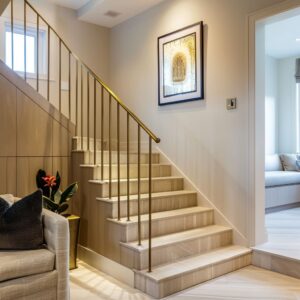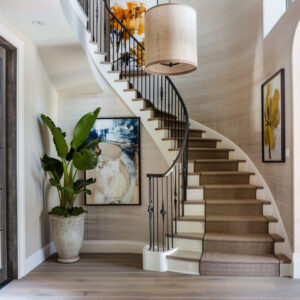The modern farmhouse style has made its mark in interior design by blending the charm of rustic living with the clean lines and minimalism of contemporary homes. This style isn’t just about weathered wood or exposed beams—it’s about combining the warmth of traditional elements with the sleekness that today’s homeowners crave.
A perfect example of this fusion can be found in the growing popularity of floating staircases within farmhouse interiors. While staircases were once functional pieces that connected floors, the floating staircase has evolved into an architectural statement, adding both style and substance to modern farmhouse homes.
The introduction of floating staircases into this design world has brought with it a fresh wave of creativity. These staircases are more than a means of getting from one floor to another—they’re a focal point, a design element that ties together various aspects of the home.
The absence of bulky support structures in floating staircases helps open up the space, creating an airy and more expansive feel, which is essential in today’s interior design trends. Whether crafted from reclaimed wood or paired with sleek metal balustrades, these staircases can blend traditional farmhouse materials with more modern elements to create something truly unique.
In this article, we’ll take a closer look at how floating staircases have become an integral part of modern farmhouse interiors. We’ll explore farmhouse staircase ideas that incorporate rustic elements with a contemporary edge, showing how these designs can balance old-world charm with modern-day function.
From maximizing space with under-stair storage to playing with lighting and materials, there are countless ways that these staircases can transform the look and feel of a home. We’ll also delve into some modern staircase ideas that highlight the versatility of floating staircases and how they can seamlessly integrate into farmhouse settings while adding a distinct architectural flair.
The floating staircase isn’t just a trend—it’s a design feature that has the power to redefine the way we think about farmhouse interiors. With thoughtful material choices, clever storage solutions, and an eye for open, inviting spaces, these staircases are taking modern farmhouse design to a whole new level.
Blending Traditional Farmhouse Elements with Modern Architecture
In modern farmhouse interiors, the floating staircase serves as a remarkable bridge between rustic charm and contemporary architecture. Its design effortlessly marries time-honored materials like reclaimed wood and exposed beams with sleek, streamlined features.
The balance between these old and new elements creates a striking contrast that enhances the overall aesthetic without compromising the welcoming atmosphere that is so central to farmhouse design.
For example, staircases with thick wooden treads, particularly those crafted from reclaimed barn wood, bring the warmth and texture of rural living into the space. These heavy treads, in many cases, are complemented by modern farmhouse stair railings made from slim metal or glass.
The mix of materials introduces a modern edge while preserving the natural, organic feel of the home. Shiplap walls and exposed beams, often seen in these homes, continue to provide that rustic foundation, but the addition of glass railings or minimalist metal balustrades allows the floating staircase to feel light and contemporary, adding a sleek touch to the farmhouse’s traditional bones.
Moreover, the open risers frequently used in contemporary stair design further amplify this sense of openness. By creating the illusion that the steps are hovering, they invite more light to pass through the space, making the room feel larger and airier.
This is particularly effective in farmhouses with vaulted ceilings or large windows, where natural light is an essential part of the design. The transparency of glass panels used in some staircases emphasizes the floating effect, allowing the eye to travel freely from one level to the next without interruption.
This mix of traditional craftsmanship and modern simplicity results in staircases that not only connect different floors but also seamlessly blend two seemingly opposing design philosophies. The structure feels rooted in history, yet forward-thinking, allowing homeowners to enjoy the warmth of a farmhouse while embracing the sleekness of modern design trends.
The floating staircase, therefore, stands as a symbol of balance, perfectly harmonizing the old with the new, offering a modern twist on timeless elements.
Maximizing Space and Functionality
Floating staircases in modern farmhouses offer much more than just visual appeal. Their design is inherently functional, particularly when space is at a premium.
In homes with smaller layouts or areas that require creative solutions, these staircases come into their own by maximizing the vertical space without compromising the cozy feel that defines farmhouse interiors.
One of the standout features of floating stairs is the potential for utilizing the area beneath them. Rather than leaving an awkward, unused space, many farmhouse interiors incorporate clever storage solutions like built-in shelves or cabinets.
For example, under-stair shelving can be filled with decorative baskets, books, or personal treasures, adding character to the room while keeping it tidy. Some spaces even take this a step further by crafting a cozy reading nook or seating area, effectively turning what could be an overlooked part of the home into a functional, inviting spot.
This use of vertical space is a key advantage. By eliminating bulky traditional structures and relying on sleek, open risers, floating stairs free up valuable room below, which can be particularly useful in compact homes.
Whether it’s a row of neatly arranged baskets, extra cabinetry, or even a set of modern wooden railing designs that doubles as a subtle room divider, these solutions allow for both practicality and style to coexist harmoniously.
Beyond storage, the open nature of floating staircases contributes to the feeling of spaciousness. In farmhouses where natural light and an airy atmosphere are essential, floating stairs allow light to pass through freely, avoiding the heaviness associated with traditional staircases.
This design element enhances the open plan aesthetic many homeowners seek, without sacrificing the farmhouse’s inherent warmth.
In some homes, the contrast between the rustic elements of the space, such as reclaimed wood beams or shiplap walls, and sleek modern features, like glass or metal railings, creates a seamless blend between old and new. The farmhouse stair railing ideas seen in various modern designs help further this integration.
For example, the incorporation of sleek black metal rails alongside thick wooden treads adds a contemporary touch to a classic farmhouse structure, striking a balance between form and function.
Whether it’s for compact homes or simply for creating more usable space, floating staircases provide a practical and beautiful solution, offering storage and a sense of openness while maintaining the cozy, inviting atmosphere that is a hallmark of farmhouse interiors.
The Importance of Natural Light in Modern Farmhouse Interiors
One of the key aspects of a modern farmhouse is how it uses natural light to transform the atmosphere within the home. The openness of floating staircases plays a significant role in allowing light to move freely throughout the space.
With fewer solid structures to block the way, natural light streams in from windows, reflecting off the various surfaces and brightening every corner. Floating staircases not only serve as practical design elements but also act as conduits for light, adding a feeling of warmth and spaciousness to the home.
Large windows, a staple in modern farmhouse designs, amplify the effect. When a floating staircase is positioned near floor-to-ceiling windows or along a glass-walled section of the house, the interplay between light and the stairs becomes even more pronounced.
The design allows sunlight to pass through the gaps between the steps, creating dynamic shadows and a sense of continuity between different levels of the home. This clever pairing of expansive windows and open stairs allows the natural light to act as an additional layer of decoration, subtly altering the ambiance as the day progresses.
The choice of natural materials also contributes to the overall feel of lightness. In modern farmhouse interiors, materials like wood and stone are often selected for their ability to reflect and absorb light in a way that feels organic.
For example, light-colored woods, such as oak or ash, are frequently used in staircase treads, amplifying the brightness of the space. The texture of these materials, whether polished or left with a natural grain, works with the sunlight, creating an inviting, airy atmosphere.
Additionally, modern glass stair designs introduce a sleek, transparent element that enhances the movement of light through the home. Glass panels or railings used in conjunction with wood or metal stairs eliminate barriers, further enhancing the sense of openness.
These design choices reinforce the idea that the staircase is more than just a functional feature—it becomes a central element that plays a critical role in the home’s lighting and overall aesthetic.
Through the strategic use of natural light, large windows, and open staircases, modern farmhouses manage to create a balance between rustic charm and contemporary elegance. It’s this thoughtful blending of light and design that allows the interior to feel both cozy and expansive, embodying the true essence of a modern farmhouse.
The Beauty of Natural Materials
At the heart of modern farmhouse design lies a deep appreciation for natural materials. The use of reclaimed wood, stone, and metal breathes authenticity into these spaces, making them feel warm and lived-in while still embracing modern aesthetics.
Floating staircases in these homes embody this balance, where the raw textures of nature are artfully combined with sleek, contemporary design elements.
One of the most striking features of farmhouse staircases is the use of wide oak treads. The natural grain of oak, whether left unfinished for a rustic look or lightly treated for a smoother finish, immediately draws attention.
These thick wooden steps not only add character but also provide durability, making them a perfect choice for high-traffic areas like staircases. In many homes, these treads are paired with exposed wooden beams that reinforce the farmhouse’s connection to its rustic roots.
Whether used in the staircase itself or in the surrounding architectural details, these beams introduce a sense of warmth that is unmistakably farmhouse.
The marriage of modern design elements with traditional materials is what sets these staircases apart. For example, a modern staircase railing idea might involve the use of minimalist metal balustrades that contrast against the rustic wood.
The clean lines of metal handrails or brackets create an interesting interplay with the rough textures of reclaimed wood, adding a contemporary twist to the otherwise traditional staircase.
In some designs, glass railings are used to further emphasize the floating effect of the stairs. The transparency of glass allows the beauty of the wood to take center stage while ensuring that the staircase remains light and open.
This approach works particularly well in homes where maximizing the flow of light is a priority, as glass keeps the sightlines clear and prevents the staircase from feeling heavy or enclosed.
Reclaimed wood, in particular, is a favorite material in modern farmhouse staircases. Whether sourced from old barns or industrial buildings, this wood brings with it a history and texture that cannot be replicated by new materials.
Weathered wood, with its imperfections and natural patina, gives the staircase an authentic charm, while the overall design keeps it looking fresh and relevant.
A great example of this combination is seen in staircases with hand-hewn beams and reclaimed treads paired with metal supports. These supports, often made of industrial steel or iron, provide strength while maintaining the open, airy feeling that floating stairs offer.
This type of modern wood stair design brings together the old-world craftsmanship of hand-carved beams with the simplicity of modern construction techniques.
In farmhouse interiors, it’s not just about the materials themselves but how they are combined. The use of weathered wood and exposed beams serves as a nod to the farmhouse’s origins, while the clean lines and modern touches ensure the space feels up-to-date.
This careful balancing act of old and new is what makes modern farmhouse staircases so captivating. The result is a space that feels both grounded in history and open to the present—where the beauty of natural materials can shine, enhanced by thoughtful design.
Integrating Staircases with the Interior Decor
Floating staircases in modern farmhouse interiors often serve as more than just a structural element—they become a defining focal point that anchors the entire room’s design. These staircases effortlessly influence the surrounding decor, guiding design choices that complement their striking features.
Because of their bold yet minimal presence, floating staircases invite homeowners to carefully consider the details in adjacent spaces, blending aesthetics with functionality.
One of the most popular approaches is to pair the staircase with natural textures and neutral color palettes. Soft, woven rugs, earth-toned walls, and cozy textiles create a welcoming backdrop that contrasts with the sharp lines of the staircase.
Take, for example, the pairing of wide wooden treads with crisp, black metal balustrades. The interplay between the natural warmth of the wood and the sleek, industrial feel of the metal creates a visual harmony that is further enhanced by the room’s understated decor.
Functionality is also a key element in the design, with staircases seamlessly integrating practical features into their structure. One of the most notable contemporary staircase ideas is to use the space beneath the floating stairs for built-in storage.
These clever solutions, like bookshelves or cabinets, not only maximize square footage but also contribute to the overall decor. Imagine a farmhouse living room where the staircase transitions smoothly into open shelving, housing everything from books and family photos to rustic woven baskets.
Incorporating natural elements into the staircase design is another way to create visual balance. Planter boxes built into the staircase or lush greenery placed strategically near the steps help soften the industrial materials, such as metal handrails or glass balustrades.
For instance, consider a staircase with wide reclaimed wood treads, flanked by a planter filled with ferns or succulents.
These modern stairwell ideas don’t just offer a way to connect levels within a home—they shape the entire feel of the space. By choosing design elements that echo the natural materials of the staircase, homeowners can create a flow that feels effortless.
Staircases with wooden treads, whether paired with metal or glass, serve as the perfect foundation for a room that embraces soft textures and warm hues.
Lighting: Bringing the Floating Staircase to Life
Lighting plays a vital role in transforming a floating staircase from a simple architectural feature into a standout element within a farmhouse. Subtle yet strategic illumination not only accentuates the craftsmanship of the staircase but also enhances its floating effect, making the structure appear almost weightless.
One of the most effective ways to bring out the visual appeal of a floating staircase is by using LED lighting. Discreetly placed under the steps, these lights gently illuminate the edges, drawing attention to the natural grain of the wood.
When paired with wide treads made from reclaimed timber, the glow emphasizes the unique textures and imperfections, which are central to the farmhouse aesthetic.
Beyond merely enhancing the staircase itself, lighting choices also help shape the overall ambiance of the space. Soft, warm lighting creates an inviting atmosphere, making the staircase feel integrated into the farmhouse’s cozy environment.
By drawing the eye upwards, these lighting techniques not only enhance the staircase but also highlight the surrounding architectural features, such as exposed wooden beams or textured stone walls.
Another noteworthy effect of lighting in floating staircases is the way it complements modern railing design. For example, farmhouse interiors often feature industrial-style metal handrails or glass balustrades.
These modern elements can feel a bit stark against the warmth of natural wood or stone, but lighting softens the contrast, balancing the old with the new.
In addition to general ambiance, lighting also serves practical purposes. Well-lit floating staircases offer safety, particularly at night, without the need for harsh overhead lighting.
The placement of lights under the treads provides a gentle glow, guiding footsteps while maintaining the visual flow of the room. By carefully choosing and placing lighting, homeowners can elevate the floating staircase beyond its structural purpose, turning it into a key feature that enhances both form and function within the farmhouse.
Bringing it All Together: A Harmonious Blend of Design Elements
Floating staircases are the perfect embodiment of how modern farmhouse interiors blend old-world charm with contemporary flair. These staircases don’t just serve as a functional element—they bring the entire design together, from the choice of materials to the seamless interaction between light and space.
The beauty of a floating staircase lies in its ability to complement all aspects of a home’s design, making it both a striking focal point and an integral part of the farmhouse aesthetic.
The versatility of floating staircases allows them to adapt to a wide range of styles within the farmhouse genre. Whether the design leans towards minimalist, with clean lines and subtle details, or embraces rustic-chic with rich wood textures and industrial accents, floating stairs fit effortlessly.
A staircase crafted from reclaimed wood can evoke the timeless appeal of a traditional farmhouse, while the addition of sleek metal or glass railings adds a modern touch.
The magic of farmhouse interiors lies in how they harmonize seemingly contrasting elements. Floating staircases bridge the gap between tradition and modernity, offering the structural integrity of heavy wood treads paired with the lightness of open risers and contemporary materials.
The farmhouse staircase railing ideas that combine metal, wood, and even glass show how modern elements can coexist with rustic materials.
What makes floating staircases particularly captivating is their balance of function and beauty. Beyond their aesthetic appeal, they also serve practical purposes, such as maximizing space and enhancing light flow throughout the home.
This balance is key in farmhouse design, where the cozy warmth of traditional architecture must meet the needs of modern living.
Ultimately, floating staircases tie everything together, bringing cohesiveness to the space. They act as a central element that enhances the room’s natural light, showcases the choice of materials, and supports the home’s overall design narrative.
Conclusion
Floating staircases have revolutionized farmhouse interiors, introducing a modern twist while maintaining the warmth and timeless appeal that define the farmhouse style. By seamlessly blending old-world materials like reclaimed wood and exposed beams with sleek, contemporary elements such as glass and metal, floating staircases offer a fresh, elegant addition to any home.
For homeowners considering a renovation or looking to elevate their home’s interior, a floating staircase provides the perfect balance between practicality and beauty. Whether you’re inspired by traditional or contemporary staircase design ideas, these staircases offer endless possibilities for customization, adapting effortlessly to various styles within the modern farmhouse aesthetic.
In today’s design landscape, floating staircases embody the best of both worlds—celebrating the craftsmanship of the past while embracing the clean lines and innovation of modern design. They are a true representation of how far farmhouse interiors have come, blending rustic charm with contemporary elegance.

